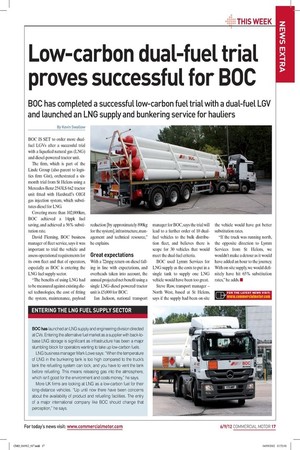Low-carbon dual-fuel trial proves successful for BOC
Page 12

If you've noticed an error in this article please click here to report it so we can fix it.
BOC has completed a successful low-carbon fuel trial with a dual-fuel LGV and launched an LNG supply and bunkering service for hauliers
By Kevin Swallow BOC IS SET to order more dualfuel LGVs after a successful trial with a liqueied natural gas (LNG) and diesel-powered tractor unit.
The irm, which is part of the Linde Group (also parent to logistics irm Gist), orchestrated a sixmonth trial from St Helens using a Mercedes-Benz 2543LS 6x2 tractor unit itted with Hardstaff’s OIGI gas injection system, which substitutes diesel for LNG.
Covering more than 102,000km, BOC achieved a 14ppk fuel saving, and achieved a 56% substitution rate.
David Fleming, BOC business manager of leet service, says it was important to trial the vehicle and assess operational requirements for its own leet and that of operators, especially as BOC is entering the LNG fuel supply sector.
“The beneits of using LNG had to be measured against existing diesel technologies, the cost of itting the system, maintenance, payload reduction [by approximately 890kg for the system], infrastructure, management and technical resource,” he explains.
Great expectations
With a 7.2mpg return on diesel falling in line with expectations, and overheads taken into account, the annual projected net beneit using a single LNG-diesel powered tractor unit is £5,000 for BOC.
Ian Jackson, national transport manager for BOC, says the trial will lead to a further order of 10 dualfuel vehicles to the bulk distribution leet, and believes there is scope for 30 vehicles that would meet the dual-fuel criteria.
BOC used Lymm Services for LNG supply as the costs to put in a single tank to supply one LNG vehicle would have been too great.
Steve Raw, transport manager – North West, based at St Helens, says if the supply had been on-site the vehicle would have got better substitution rates.
“If the truck was running north, the opposite direction to Lymm Services from St Helens, we wouldn’t make a detour as it would have added an hour to the journey. With on-site supply, we would deinitely have hit 65% substitution rates,” he adds. ■
ENTERING THE LNG FUEL SUPPLY SECTOR
BOC has launched an LNG supply and engineering division directed at CVs. Entering the alternative fuel market as a supplier with back-tobase LNG storage is significant as infrastructure has been a major stumbling block for operators wanting to take up low-carbon fuels.
LNG business manager Mark Lowe says: “When the temperature of LNG in the bunkering tank is too high compared to the truck’s tank the refuelling system can lock, and you have to vent the tank before refuelling. This means releasing gas into the atmosphere, which isn’t good for the environment and costs money,” he says.
More UK firms are looking at LNG as a low-carbon fuel for their long-distance vehicles. “Up until now there have been concerns about the availability of product and refuelling facilities. The entry of a major international company like BOC should change that perception,” he says.











































